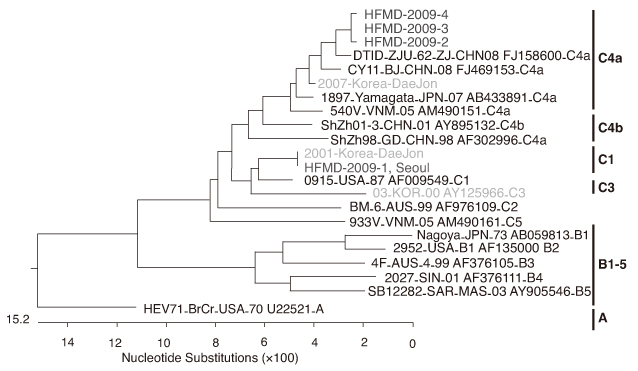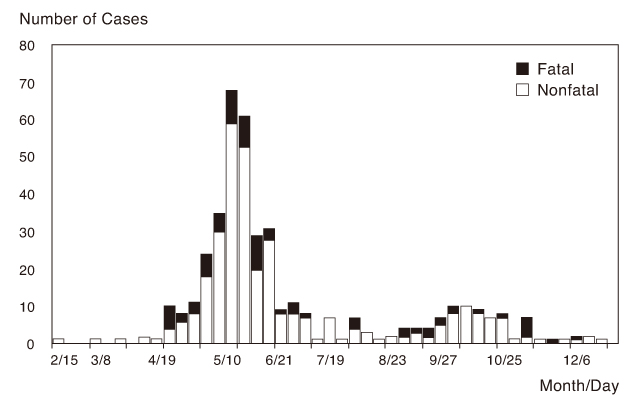J Korean Med Assoc.
2009 Sep;52(9):886-894. 10.5124/jkma.2009.52.9.886.
Hand-Foot-Mouth Disease Related to Enterovirus 71
- Affiliations
-
- 1Department of Childhood and Adolescent Medicine, College of Medicine, The Catholic University of Korea, Korea.
- 2Division of Enteric and Hepatitis Viruses, National Institute of Health, Korea Centers for Disease Control and Prevention, Korea. jh00mn@catholic.ac.kr
- KMID: 1936493
- DOI: http://doi.org/10.5124/jkma.2009.52.9.886
Abstract
- Hand-foot-mouth disease (HFMD), one of the more distinctive rash syndromes, is most frequently caused by coxsackievirus A16, but can also be caused by enterovirus 71 (EV71) and other coxsackieviruses. Recently, there have been large outbreaks of simple, neurologically complicated and even fatal HFMD caused by EV71 in Western Pacific Area. However, in the Republic of Korea, despite its location in EV71 endemic Western Pacific Area, published reports on HFMD with EV71 are rare and there are no published reports on fatal cases. After the first fatal case of HFMD caused by EV71 announced in May 2009, much more cases of neurologically complicated HFMD have been announced. Even now, physician's increased awareness about the seriousness of HFMD, viral surveillance and early warning system of HFMD, and early detection and proper management of potentially life threatening HFMD caused by EV71 are required in the Republic of Korea, as in the neighboring countries.
Keyword
Figure
Cited by 1 articles
-
Epidemiology and Clinical Characteristics of Enterovirus Infections in Children: A Single Center Analysis from 2006 to 2010
In-Soo Park, Hae Sung Lee, Soo-Han Choi, Hye Jin Kim, Seo Yeon Hwang, Doo-Sung Cheon, Jin-Keun Chang
Korean J Pediatr Infect Dis. 2013;20(2):81-88. doi: 10.14776/kjpid.2013.20.2.81.
Reference
-
1. Abzug MJ. Kliegman RM, editor. Nonpolio enteroviruses. Nelson textbook of pediatrics. 2007. 18th ed. Philadelphia: WB Saunders;1350–1356.
Article2. Podin Y, Gias EL, Ong F, Leong YW, Yee SF, Yusof MA, Perera D, Teo B, Wee TY, Yao SC, Yao SK, Kiyu A, Arif MT, Cardosa MJ. Sentinel surveillance for human enterovirus 71 in Sarawak, Malaysia: lessons from the first 7 years. BMC Public Health. 2006. 6:180.
Article3. Ho M, Chen ER, Hsu KH, Twu SJ, Chen KT, Tsai SF, Wang JR, Shih SR. Taiwan Enterovirus Epidemic Working Group. An epidemic of enterovirus 71 infection in Taiwan. N Engl J Med. 1999. 341:929–935.
Article4. Tu PV, Thao NT, Perera D, Huu TK, Tien NT, Thuong TC, How OM, Cardosa MJ, McMinn PC. Epidemiologic and virologic investigation of hand, foot, and mouth disease, southern Vietnam, 2005. Emerg Infect Dis. 2007. 13:1733–1741.
Article5. Zhang Y, Tan XJ, Wang HY, Yan DM, Zhu SL, Wang DY, Ji F, Wang XJ, Gao YJ, Chen L, An HQ, Li DX, Wang SW, Xu AQ, Wang ZJ, Xu WB. An outbreak of hand, foot, and mouth disease associated with subgenotype C4 of human enterovirus 71 in Shandong, China. J Clin Virol. 2009. 44:262–267.
Article6. Roh HK, Chung HJ, Jee YM, Cheon DS. A case of polio-like encephalomyelitis associated with enterovirus 71 infection. J Korean Pediatr Soc. 2001. 44:1305–1310.7. Jee YM, Cheon DS, Kim K, Cho JH, Chung YS, Lee J, Lee SH, Park KS, Lee JH, Kim EC, Chung HJ, Kim DS, Yoon JD, Cho HW. Genetic analysis of the VP1 region of human enterovirus 71 strains isolated in Korea during 2000. Arch Virol. 2003. 148:1735–1746.
Article8. Korea Centers for Disease Control and Prevention. Case reports and genetic identification of serious infections by enterovirus 71 in Korea, 2009. Public Health Weekly Report. 2009. 2:328–329.9. Shimizu H, Utama A, Onnimala N, Li C, Li-Bi Z, Yu-Jie M, Pongsuwanna Y, Miyamura T. Molecular epidemiology of enterovirus 71 infection in the Western Pacific Region. Pediatr Int. 2004. 46:231–235.
Article10. Schmidt NJ, Lennette EH, Ho HH. An apparently new enterovirus isolated from patients with disease of the central nervous system. J Infect Dis. 1974. 129:304–309.
Article11. Shindarov LM, Chumakov MP, Voroshilova MK, Bojinov S, Vasilenko SM, Iordanov I, Kirov ID, Kamenov E, Leshchinskaya EV, Mitov G, Robinson IA, Sivchev S, Staikov S. Epidemiological, clinical, and pathomorphological characteristics of epidemic poliomyelitis-like disease caused by enterovirus 71. J Hyg Epidemiol Microbiol Immunol. 1979. 23:284–295.12. Nagy G, Takátsy S, Kukán E, Mihály I, Dömök I. Virological diagnosis of enterovirus type 71 infections: experiences gained during an epidemic of acute CNS diseases in Hungary in 1978. Arch Virol. 1982. 71:217–227.
Article13. Brown BA, Oberste MS, Alexander JP Jr, Kennett ML, Pallansch MA. Molecular epidemiology and evolution of enterovirus 71 strains isolated from 1970 to 1998. J Virol. 1999. 73:9969–9975.
Article14. Chen KT, Chang HL, Wang ST, Cheng YT, Yang JY. Epidemiologic features of hand-foot-mouth disease and herpangina caused by enterovirus 71 in Taiwan, 1998-2005. Pediatrics. 2007. 120:244–252.
Article15. Mizuta K, Abiko C, Murata T, Matsuzaki Y, Itagaki T, Sanjoh K, Sakamoto M, Hongo S, Murayama S, Hayasaka K. Frequent importation of enterovirus 71 from surrounding countries into the local community of Yamagata, Japan, between 1998 and 2003. J Clin Microbiol. 2005. 43:6171–6175.
Article16. Wang SM, Ho TS, Shen CF, Liu CC. Enterovirus 71, one virus and many stories. Pediatr Neonatol. 2008. 49:113–115.
Article17. Lin TY, Chang LY, Hsia SH, Huang YC, Chiu CH, Hsueh C, Shih SR, Liu CC, Wu MH. The 1998 enterovirus 71 outbreak in Taiwan: pathogenesis and management. Clin Infect Dis. 2002. 34:Suppl 2. 52–57.
Article18. Chang LY, Lin TY, Hsu KH, Huang YC, Lin KL, Hsueh C, Shih SR, Ning HC, Hwang MS, Wang HS, Lee CY. Clinical features and risk factors of pulmonary oedema after enterovirus-71-related hand, foot, and mouth disease. Lancet. 1999. 354:1682–1686.
Article19. PÈrez-VÈlez CM, Anderson MS, Robinson CC, McFarland EJ, Nix WA, Pallansch MA, Oberste MS, GlodÈ MP. Outbreak of neurologic enterovirus type 71 disease: a diagnostic challenge. Clin Infect Dis. 2007. 45:950–957.
Article20. Wang SM, Lei HY, Huang MC, Wu JM, Chen CT, Wang JN, Wang JR, Liu CC. Therapeutic efficacy of milrinone in the management of enterovirus 71-induced pulmonary edema. Pediatr Pulmonol. 2005. 39:219–223.
Article21. Huang MC, Wang SM, Hsu YW, Lin HC, Chi CY, Liu CC. Long-term cognitive and motor deficits after enterovirus 71 brainstem encephalitis in children. Pediatrics. 2006. 118:1785–1788.
Article22. Prager P, Nolan M, Andrews IP, Williams GD. Neurogenic pulmonary edema in enterovirus 71 encephalitis is not uniformly fatal but causes severe morbidity in survivors. Pediatr Crit Care Med. 2003. 4:377–381.
Article
- Full Text Links
- Actions
-
Cited
- CITED
-
- Close
- Share
- Similar articles
-
- Hand, foot and mouth disease associated with the aseptic meningitis in Seoul, 1990
- Paralytic Disease Related to Enterovirus 71 Infection: A report of 4 cases
- Two Cases of Hand-Foot-Mouth Disease with Neurologic Manifestations
- A Case of Enterovirus 71 Infection Presented with Acute Flaccid Paralysis
- A Case of Onychomadesis after Recovering from Hand-Foot-Mouth Disease





